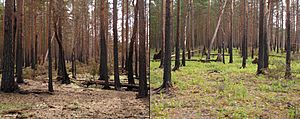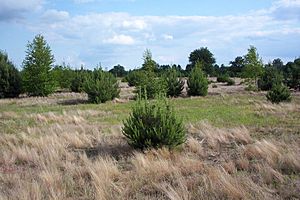Ecological succession facts for kids
Ecological succession is how an ecosystem changes over time after something like a fire or flood. It's a bit like watching a movie of nature growing back and changing in a predictable way. Over many years, different types of plants and animals move into an area, creating a new community.
Contents
Types of Succession
Primary Succession: Starting from Scratch

1. A stable deciduous forest community
2. A disturbance, such as a wild fire, destroys the forest
3. The fire burns the forest to the ground
4. The fire leaves behind empty, but not destroyed, soil
5. Grasses and other herbaceous plants grow back first
6. Small bushes and trees begin to colonize the area
7. Fast growing evergreen trees develop to their fullest, while shade-tolerant trees develop in the understory
8. The short-lived and shade intolerant evergreen trees die as the larger deciduous trees overtop them. The ecosystem is now back to a similar state to where it began.
Imagine a brand new piece of land, like rock from a volcano or sand from a glacier. Nothing has ever grown there before. When life starts to appear on such a place, it's called primary succession.
First, tiny plants like lichens and mosses grow. They are called "pioneer plants" because they are the first ones to arrive. These plants help break down the rock and create soil. Then, grasses and small shrubs start to grow. After that, bigger trees begin to appear.
As plants grow, animals slowly return because there's food and shelter for them. When the ecosystem is fully grown and stable, it's called a "climax community." For example, parts of Acadia National Park in Maine have gone through primary succession after glaciers moved away.
Secondary Succession: Nature's Comeback Story
Secondary succession happens when an area that already had an ecosystem is disturbed. This could be from a forest fire, a flood, or when people stop farming a field. The soil is usually still there, and sometimes even seeds or small living things remain.
Because the soil and some life are still present, nature can grow back much faster than in primary succession. For example, after a wildfire, new plants can sprout from seeds in the soil. Grasses and small plants often grow first. Then, bushes and trees start to take over.
Secondary succession is very common. We see it after natural events like fires or strong winds. We also see it after human activities like logging or farming. For instance, after a big flood in Shenandoah National Park in 1995, plants and animals slowly started to return.
Seasonal and Cyclic Changes
Sometimes, changes in an ecosystem happen regularly, like seasons. These are not caused by big disturbances. Instead, they are natural cycles that happen over and over. For example, some plants grow and die back each year, changing the look of an area.
What Causes Succession?
Changes from Within (Autogenic)
Sometimes, the plants and animals themselves cause changes in their environment. This is called autogenic succession. For example, plants can add organic matter to the soil when they die. This changes the soil's nutrients and how much water it holds.
Also, as big trees grow, they create shade on the forest floor. This means that plants that need a lot of sunlight can't grow there anymore. Instead, plants that like shade will start to grow.
Changes from Outside (Allogenic)
Allogenic succession happens because of things outside the ecosystem. These can be natural events or actions by animals.
- Soil Changes: Things like erosion (soil washing away) or floods (depositing new soil) can change the nutrients in the ground.
- Animals: Animals play a big role! They spread seeds, pollinate plants, and eat plants. Some animals, like moles or ants, dig in the soil. This creates new spots for certain plants to grow.
- Climate: Over very long periods, changes in temperature or rainfall can cause big shifts. For example, after the last ice age, the climate warmed. This led to huge changes as forests replaced tundra. Even today, climate change can cause big shifts in ecosystems.
- Natural Disasters: Events like volcanic eruptions, earthquakes, avalanches, or big storms can also cause allogenic changes.
How Succession Happens
In the early 1900s, a scientist named Frederic Clements described how succession works. He said it happens in several steps:
- Starting Point: It begins with a bare area, like new rock or disturbed land.
- Arrival: Seeds or spores arrive in the new area.
- Growing Up: The first plants start to grow and get established.
- Competition: As more plants grow, they start to compete for space, light, and nutrients.
- Changing the Habitat: The plants themselves change the environment. For example, they might add nutrients to the soil. This allows new types of plants to grow.
- Stable Community: Eventually, a stable "climax community" forms. This community stays mostly the same unless there's a new disturbance.
Seral Communities: Steps Along the Way
A seral community is like a temporary stage in the journey of an ecosystem. It's one of the steps an area goes through before it reaches its final, stable "climax community." Many different seral stages can happen along the way.
For example, if a pond slowly fills with sediment and plants, it might go through several seral stages. First, it's open water. Then, water plants grow. Later, the pond becomes a marsh, then a wet meadow, and finally, a forest. Each of these steps is a seral community.
Changes in Animal Life Too
Succession isn't just about plants; animals change too!
- Early Stages: In the very first stages, like when only lichens are growing, there aren't many animals. You might find tiny mites, ants, or spiders hiding in cracks.
- Grassy Stage: As grasses and small plants grow, more animals appear. This includes insects, worms, and more spiders.
- Forest Stage: When a full forest develops, the animal population grows a lot and becomes very diverse. You'll find many invertebrates like slugs, snails, and different insects. Vertebrates like squirrels, foxes, mice, snakes, birds, and frogs also move in.
The types of animals present depend on the plants and the environment. As the plants change, so do the animals that can live there.
See also
 In Spanish: Sucesión ecológica para niños
In Spanish: Sucesión ecológica para niños





